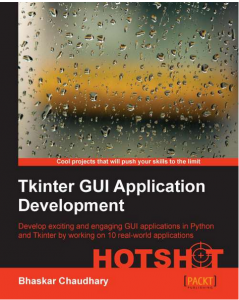[Book review] Tkinter GUI Application Development HOTSHOT
Hi guys. You might have noticed that I am not so active. The reason is that I am developing a couple of my projects as a hobby. Due to that I didn’t have a lot of time to blog. Nevertheless I will continue to write interesting posts once or twice a week. So what this post is about? Well recently I was contacted by Packt Publishers to write a book review. The book was “Tkinter GUI Application Development HOTSHOT” and is recently published. As you probably know that I am not that much proefficient in GUIs and prefer CLIs so this book gave me a good chance to brush up my skills on GUI development. Here is a quick summary for those who want to get a quick overview.
- Why I picked it up? It was given to me for the purpose of writing a book review and secondly it gave me a chance to brush up my skills a little.
- What do I rate it? 4/5
- I would give it to: Those who have a moderate Python knowledge and are currently starting GUI development in Tkinter.
- How was the writing style? I really liked it. It was an interesting read.
- What is the book link? Here you go
Full review:
So now its time for the full review. I have done GUI programming in Python using wxPython and PyQt in the past so I had the concept of how it is done. However this was going to be my first “practicle” encounter with Tkinter. English is not the authors first language so you may experience some gramatical mistakes but nevertheless he did a great job.
The book is not divided in chapters but rather in projects. There are 8 projects in total. Each project has “Mission Briefing” and “Your Hotshot Objectives”. Mission Briefing tells you what you are going to make and Your Hotshot Objectives tell you how you are going to make it. I really liked the classification on project basis and not on chapter basis. Most books teach you the concepts but do not teach you how to apply them to a real application.

The author starts of with an introductory chapter about Tkinter. Then he teaches you how to make a notepad like text editor. He does not teach the basics of Python which in my regard is great because I would not pay 10 bucks for some extra chapters on the basics when there are already great books out there for free. He has done a really good job at explaining the main concepts. I personally enjoyed the “Game of Chess” and “Drum Machine” projects. These projects showcase the creativity of the author and enhance our own creativity. While I was reading I was continuously thinking how I would apply them in PyQt. Before reading this book I wasn’t aware of the capabilities of Tkinter.
I would not suggest this book to any new Pythonista but rather to a moderately experienced one. If you are a PyQt developer or even if a wxPython one then still make sure to check this book out as it showcases some neat projects and some nice capabilities of Tkinter.
Checkout this book here and do let me know whether you like this book or not.
Is that it? No! In the next post I will run a give away for this book. If you don’t want to buy it then why not try your luck with the giveaway? Till then do follow me on Twitter, Facebook and this blog.




✍️ Comments
Thank you!
Your comment has been submitted and will be published once it has been approved. 😊
OK